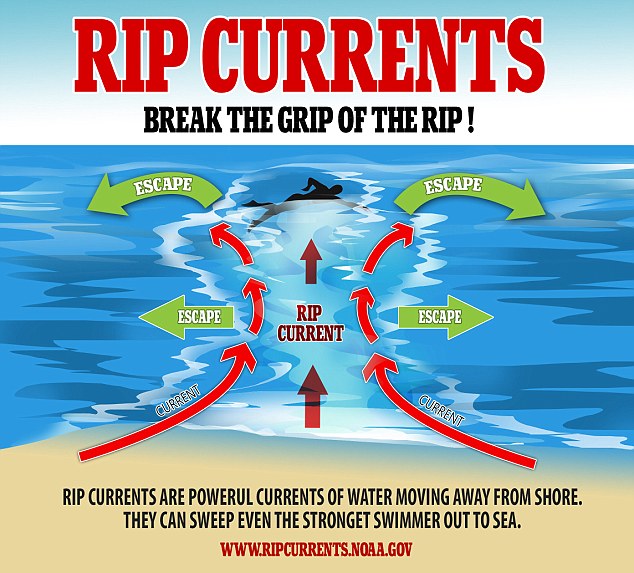By Rabbi Yair Hoffman for 5TJT.com
The recent drowning tragedies this summer underscore the need to remind us all of three very important Mitzvos that pertain to water activities:
- There is the Mitzvah of “veNishmartem me’od b’nafshosaichem (Dvarim 4:9) — the Mitzvah of protecting our health and well-being.
- The verse later on (Dvarim 4:15), “Rak hishamer lecha” is understood by most Poskim to actually comprise a second Mitzvah (See Rav Chaim Kanievsky Shlita Shaar HaTeshuvos #25) — to take special care in our safety.
- There is also a third Mitzvah, “V’Chai Bahem – And you shall live by them” (VaYikra 18:5).
RIPTIDES
All of these Mitzvos involve knowing and recognizing the danger of something called a “riptide” – and what to do – if one is caught in one.
On average, riptides kill 46 swimmers a year r”l in the United States alone. Some experts say that is as much as 100 people a year.
A riptide is a super-fast escalator that takes you deep and fast into the ocean or lake. They are long lanes of water that quickly pull swimmers in their path far away from shore and out to sea. They travel up to 5.6 miles an hour – far far faster than anyone can swim. They also absolutely exhaust even the most powerful of swimmers.
THE SIX RULES
Riptides are very dangerous, but with a little knowledge, one can easily escape from them by following this list of six rules.
- Do not fight against the current – it is too strong.
- Do not panic. When you panic it is hard to think.
- Do not swim toward shore – swim sideways – parallel to the shore and past the current.
- You should swim out of the lane. The lane can be up to 100 feet wide but is usually much less.
- If you cannot swim out of the riptide lane – float on your back. Let the riptide take you away from shore until you are beyond the pull of the current. Rip currents generally end 100 to 300 feet from shore.
- Once the riptide ends, swim parallel to the shore to avoid it, and then back to the shore.
HOW TO SPOT THEM
Riptides occur more often when there are strong winds. How do we spot them? When we see streaks of muddy or sandy water and debris moving out to the sea that is a sign that riptides are there. Also if there is an area where the height of the wave is lower than the rest of the waves – that can also be a sign.
WHY THEY HAPPEN
Sometimes, when wind and waves combine together, the surface water level goes higher than is normal. The “extra water” will go back to the open water in the path of least resistance. When one area is a bit deeper than the rest – it will cause a riptide. If there is a deeper sandbar or a reef – this can also cause a riptide.
ALSO IN LAKES
Rip tides can form in the ocean, in a sea, and even in a large lake. They can be hard to see also. It can happen because the bottom of the lake in that spot is deeper than the rest of the lake.
They can be deceptive looking. The surface of a riptide may look like a very smooth area of water, with no breaking waves. This deceptive appearance can cause people to think it is a good place to enter the water.
This article was written l’zaicher nishmas the author’s mother, Sara Bas HaRav ELiyahu – whose 12th yartzeit is today, the 22nd of Av.
The author can be reached at [email protected]












7 Responses
“Riptides are very dangerous, but with a little knowledge, one can easily escape from them by following this list of six rules.”
This is false!
With a little knowledge one may be Abel to escape but definitely not easy and still extremely dangerous. These words encourage people to not be afraid of rip current when in fact even with this knowledge they are still a big saconoh.
If you cannot swim, don’t wade into the ocean (or sea) above your ankles. Waves happen, knock you down, and you will drown. A young father waded into the Mediterranean up up to his waste, got knocked over and drowned. Terrible and needless tradgedy.
An even better idea: learn to swim. Every yeshiva should teach it.
Another thing to remember (from what I heard, not from personal experience) is NOT TO FIGHT IT, but to focus on floating WITH IT, and once it’s over to slowly float back… וה’ הטוב ירחם
Don’t forget to swim in approved areas, pay attention to red flags and never swim in an area without lifeguards.
Thanks for this important information
Yashir koach to writer for bringing this to people’s attention.
And as Amil Zola says, don’t swim or go into the water (even up to your knees) except in approved areas where there are lifeguards on duty, and obey all warnings.
And as huju points. out LEARN TO SWIM. It’s commanded by the Torah as one of the things a father must see his children learn. Yes, all yeshivas should teach it, and not just once over lightly. Every May there should be a refresher course, BEFORE young people get into the water.
No, it is not commanded by the Torah. Of the whole list of things the gemora in kidushin says a father must teach his son, this is the only item that is NOT brought lehalocho. It’s still a good idea, but it’s not a mitzvah.